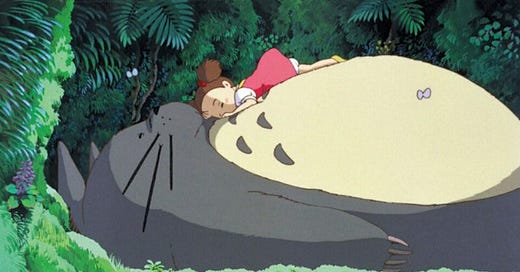Your Book's Setting as a Character
Effective world-building and how to write atmospheric settings that pop and add more to your novel than just trees and grass. A case study with excerpts from my favorite authors.
Hello there, my brilliant writer friends!
There’s a thing I do before I start writing a new book—I read the first chapter of another author who excels at bringing settings to life. I love immersing myself in this experience; it settles my soul and reminds me that my goal is to write stories that are not only un-put-down-able, but also viscerally beautiful.
There is an alchemy to being able to describe a place and make it more than just a list of buildings and flora, and today, I’m going to show you how it’s done.
My favorite authors on setting
These writers create worlds that live and breathe. It’s not a phenomenon limited to fantasy books, either. Settings in contemporary novels can also be vividly real. Here are a few examples:
Natasha Pulley
“The train had just come in. The platform was full of people looking slow and stiff from the journey, all moving towards the concourse. The sweet carbon smell of coal smoke was everywhere. Because it was only just light outside, the round lamps of the station gave everything a pale glow, and cast long, hazy shadows; even the steam had a shadow, a shy devil trying to decide whether to be solid or not.” — The Kingdoms
Sarah Addison Allen
“Zoey took a steadying breath and walked to the gate, which bore a weathered brass sign that read The Dellawisp. She pushed it open and the hinges squeaked, piercing the silence. In front of her was a small, overgrown center garden. She stepped inside and followed the brick pathway lined with short trees bearing clusters of disproportionately large, bell-shaped blooms. They gave off a cloying scent like a bottle of dropped perfume. Her backpack brushed one of the trees as she passed, and suddenly a swirl of tiny turquoise birds flew out…. They were exquisite little things, some no bigger than ring boxes. She watched as one found her shoelace and began to pull on it with its sherbet-orange beak.” — Other Birds
Audrey Niffenegger
“The library is cool and smells like carpet cleaner, although all I can see is marble. I sign the Visitors’ Log: Clare Abshire, 11:15 10-26-91 Special Collections. I have never been to the Newberry Library before, and now that I’ve gotten past the dark, foreboding entrance, I have a sort of Christmas-morning sense of the library as a big box full of beautiful books…. My boot heels rap the wooden floor. The room is quiet and crowded, full of silent, heavy tables piled with books and surrounded by readers. Chicago autumn morning light shines through the tall windows.” — The Time Traveler’s Wife
The keys to making your setting come alive:
1. The first, most important element is voice.
Each of these excerpts immediately sweeps you away in the voice of the narrator. Sometimes it’s the character who is telling the story, Other times—as in The Kingdoms—it’s an outside perspective.
Voice is a big topic of its own (I promise to dedicate a future newsletter to finding your voice), but for now, just note that these opening settings in these books firmly establish from the get-go what kind of voice the reader can expect.
Infusing any setting description with voice automatically elevates it from mere statement of facts to something that is suffused with your personal magic as a writer.
Don’t forget to check out:
Most recent newsletters: Will AI Make Novelists Extinct?
2. Use of other senses
A common mistake for writers just starting out is to make their setting descriptions just an invoice of visual elements—a group of tall trees; an old brown building; a vast green lake.
Notice, though, that the examples above all include at least one other sense. You don’t want to go overboard, but including one or two senses other than sight will round out your setting descriptions.
Smell is one of the easiest to incorporate:
“the sweet carbon smell of coal smoke…”
“a cloying scent like a bottle of dropped perfume”
“the library… smells like carpet cleaner”
Feel or touch is also relatively easy, especially if your character is already in the scene:
“She watched as one [of the birds] found her shoelace and began to pull on it with its sherbet-orange beak.”
“my boot heels rap the wooden floor”
Go back through the examples above and see what other senses you can identify. Hearing? Taste?
Now think about how you could flesh out your own introductory settings with the five senses.
And now for the final two secrets, which are my favorite:
3. Integrating action
Make your setting vivid by subtly integrating action into it. You might not have even noticed that the authors above did this, so let’s take another look (highlighted in bold):
“The train had just come in. The platform was full of people looking slow and stiff from the journey, all moving towards the concourse. The sweet carbon smell of coal smoke was everywhere. Because it was only just light outside, the round lamps of the station gave everything a pale glow, and cast long, hazy shadows; even the steam had a shadow, a shy devil trying to decide whether to be solid or not.” — The Kingdoms by Natasha Pulley
“Zoey took a steadying breath and walked to the gate, which bore a weathered brass sign that read The Dellawisp. She pushed it open and the hinges squeaked, piercing the silence. In front of her was a small, overgrown center garden. She stepped inside and followed the brick pathway lined with short trees bearing clusters of disproportionately large, bell-shaped blooms. They gave off a cloying scent like a bottle of dropped perfume. Her backpack brushed one of the trees as she passed, and suddenly a swirl of tiny turquoise birds flew out…. They were exquisite little things, some no bigger than ring boxes. She watched as one found her shoelace and began to pull on it with its sherbet-orange beak.” — Other Birds by Sarah Addison Allen
“The library is cool and smells like carpet cleaner, although all I can see is marble. I sign the Visitors’ Log: Clare Abshire, 11:15 10-26-91 Special Collections. I have never been to the Newberry Library before, and now that I’ve gotten past the dark, foreboding entrance, I have a sort of Christmas-morning sense of the library as a big box full of beautiful books…. My boot heels rap the wooden floor. The room is quiet and crowded, full of silent, heavy tables piled with books and surrounded by readers. Chicago autumn morning light shines through the tall windows.” — The Time Traveler’s Wife by Audrey Niffenegger
Do you see now how adding movement makes the setting feel that much more real and alive? It’s no longer just a list of physical objects; it’s now populated with the life of people, whether it’s the main characters or others who live in the world.
This is what I mean about making your setting a character. It’s not just a static, lifeless thing. Your setting contributes to the ambience of the story. Think about Mei sleeping on Big Totoro. Your story is Mei, and your setting is Totoro—the setting’s inhales and exhales quietly affect the rest of your story.
4. Bonus tip
If you can make your setting be part of the conflict, you further bring the world to life.
My favorite example is in The Raven Cycle series by Maggie Stiefvater. There, the trees whisper in Latin, and the dream world collides with the real world, sometimes protecting and cushioning the main characters, and sometimes making things a lot, lot worse. (I won’t say more because I don’t want to spoil the books for anyone who hasn’t read them yet. But if you haven’t, Maggie is a master at writing ambience and living, breathing settings.)






